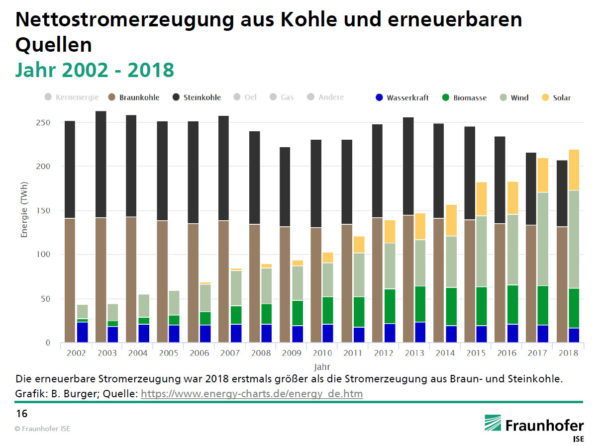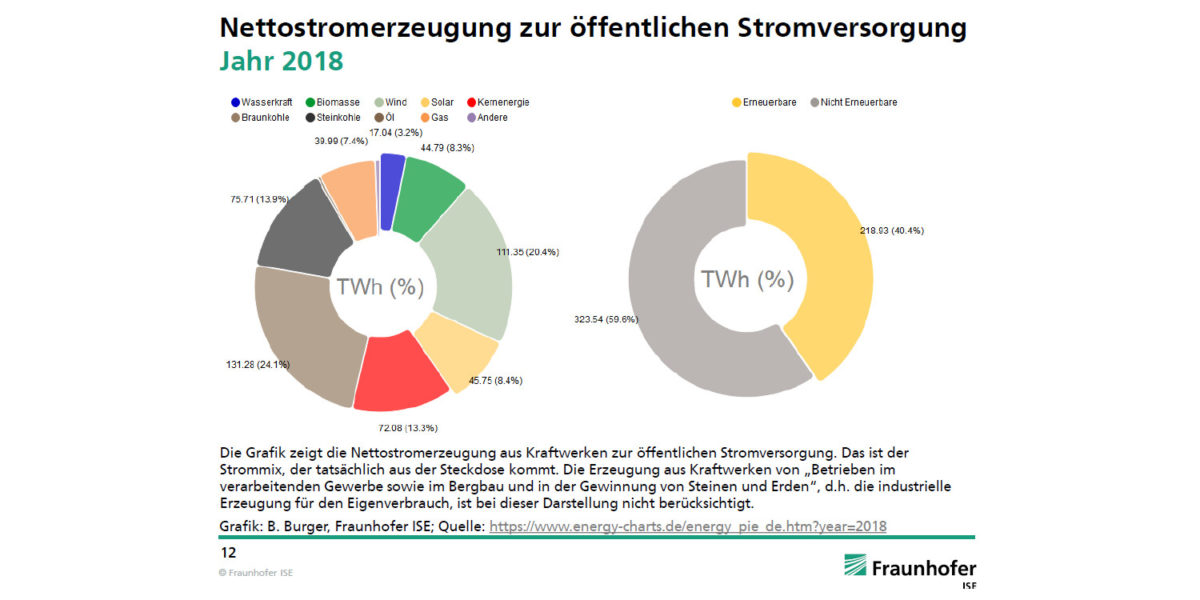Already by the year's end, reports on the expected electricity generation for 2018 had piled up. On January 1, Fraunhofer ISE presented its analysis regarding net electricity generation in Germany in 2018, with the numbers showing that solar PV has the highest growth rate among all electricity sources. According to the report PV grew by 6.3 terawatt-hours (TWh) to reach 45.7 TWh in 2018. This translates into an increase of 16% and allowed PV to comprise 8.4% of the total public electricity supply.
For the entire year, Fraunhofer ISE expects PV capacity additions of around 3.2 GW; although the final numbers for additions have not yet been made public by the German Federal Network Agency. The report marks as a highlight for this year that on July 2 at 1:15 pm PV reached peak production of 32 GW. At this moment, 39% of the electricity generated in Germany came from PV. On May 6, PV reached the highest daily average share with 22.6%. Additionally, the authors of the report stress that the monthly generation of PV systems in Germany between April and August had been higher each month than that of hard coal.
Aside from photovoltaics the generation from wind energy also increased over the last year. German wind turbines produced 5.4% more than last year and reached 111 TWh, with wind comprising 20.4% of net electricity generation. This makes wind energy the second-largest energy source after lignite coal in Germany. On December 8 at noon, winds production capacity peaked at 45.9 GW.
“In 2018, solar and wind produced 157 TWh jointly – that is more than lignite coal, hard coal, and nuclear power,” writes Fraunhofer ISE in its report.
Biomass reached 44.8 TWh, similar to last year's generation. Hydropower has decreased, not the least due to the long very dry summer this year. Its contribution to the public electricity supply fell by 15.2% to reach 17 TWh. This is the second-lowest production number in thirty years, the authors say – only in 1991 did hydropower comprise an even smaller share. In total renewable energy reached 219 TWh, which is 4.3% higher than in 2017. For the first time, the percentage of renewable energy resources in Germany’s net electricity generation climbed over 40%, according to the report.

Graph: Fraunhofer ISE
The analysis of Fraunhofer ISE also shows that all fossil fuel-based energy resources declined over the last year. Nuclear power dropped a minuscule 0.1%. The electricity production from lignite and hard coal decreased by 2% and 7.4% respectively. The output from gas-fired power stations decreased by 18.5%.
According to the authors, lignite (brown coal) generators manage to respond more flexibly to spot market prices, compared to last year. On multiple days lignite's average production share was below 6 GW. However, these generators are still not flexible enough to respond to renewable energy feeding into the grid, the report notes. Lignite accounted for 131 TWh of net electricity production. Hard coal (anthracite) reached 75.7 TWh, nuclear power 72.2 TWh, and gas-fired power stations generated 40 TWh.
This content is protected by copyright and may not be reused. If you want to cooperate with us and would like to reuse some of our content, please contact: editors@pv-magazine.com.




1 comment
By submitting this form you agree to pv magazine using your data for the purposes of publishing your comment.
Your personal data will only be disclosed or otherwise transmitted to third parties for the purposes of spam filtering or if this is necessary for technical maintenance of the website. Any other transfer to third parties will not take place unless this is justified on the basis of applicable data protection regulations or if pv magazine is legally obliged to do so.
You may revoke this consent at any time with effect for the future, in which case your personal data will be deleted immediately. Otherwise, your data will be deleted if pv magazine has processed your request or the purpose of data storage is fulfilled.
Further information on data privacy can be found in our Data Protection Policy.